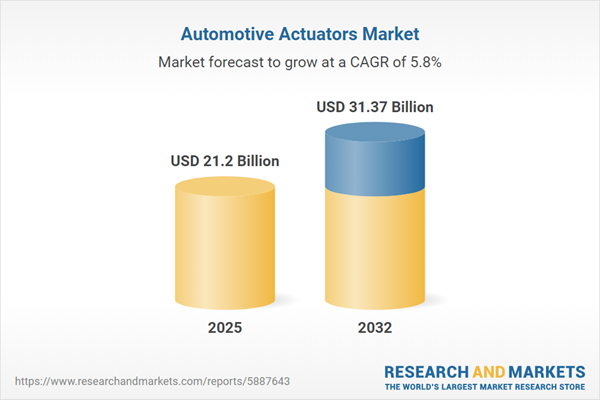Speak directly to the analyst to clarify any post sales queries you may have.
The automotive actuators market is undergoing substantial transformation as senior decision-makers navigate regulatory complexity, evolving supply chains, and rapid technology shifts. Strategic adoption of automation and an intensified focus on sustainability are driving innovation, compelling companies to act with agility to strengthen their competitive positioning.
Automotive Actuators Market Snapshot
The automotive actuators market is exhibiting robust growth, propelled by widespread vehicle automation initiatives and expanding digitalization throughout the automotive ecosystem. Actuators are now integral within digital vehicle architectures, providing the precision and reliability required to support both traditional and emerging vehicle categories. Increased regulatory demands and an industry-wide shift toward large-scale electric vehicle production are prompting suppliers to advance actuator capabilities, placing greater emphasis on efficiency, improved system reliability, and enhanced passenger comfort. To address shifting consumer expectations as well as regulatory mandates, manufacturers and aftermarket partners are refining actuator solutions that better align with evolving standards and preferences.
Scope & Segmentation of the Automotive Actuators Market
- Actuator Types: Electric actuator solutions utilize advanced brushless DC motors, conventional DC motors, and stepper motors to deliver heightened accuracy and energy management across automotive applications. Hydraulic and pneumatic actuators—including piston, diaphragm, single-acting, and double-acting variants—are engineered to support specialized requirements within powertrain and auxiliary systems.
- Applications: Actuators serve as crucial components across a spectrum of vehicle systems, including braking systems, HVAC, seat adjustment, mirror positioning, steering mechanisms, throttle control, power windows, transmission, door locking, and occupant comfort and safety solutions. Each function directly influences vehicle performance and end-user experience.
- Vehicle Platforms: The market covers commercial vehicles such as trucks, vans, and buses, as well as off-road equipment used in construction, agriculture, and defense sectors. A diverse range of passenger vehicles, including sedans, hatchbacks, and SUVs, are also addressed, each presenting distinct requirements for durability, adaptability, and ergonomic integration.
- Sales Channels: Delivery takes place through original equipment manufacturers (OEMs), dealership networks, and independent distributors. This channel mix ensures broad accessibility to both OEM and aftermarket actuator solutions designed for varying operational timelines.
- Regions: The Americas—with prominent participation from the US and Canada—EMEA (incorporating Germany, UK, France, Middle East, and Africa), and Asia-Pacific (including China, Japan, India, and Southeast Asia) present region-specific dynamics influencing innovation, adoption rates, and compliance standards.
- Key Companies: Leading organizations, including Robert Bosch GmbH, DENSO Corporation, Magna International Inc., Continental AG, ZF Friedrichshafen AG, Aisin Seiki Co., Ltd., Valeo SA, Hitachi Astemo Ltd., Aptiv PLC, and BorgWarner Inc., are shaping technical benchmarks and compliance frameworks across the market.
Automotive Actuators Market: Key Takeaways for Leadership
- The convergence of electrification trends and digital connectivity is accelerating the market need for actuators with integrated diagnostics and real-time monitoring features, enabling faster operational responses.
- Collaboration with material and technology suppliers supports the integration of advanced sensor systems and durable materials, which are vital for aligning with tightening industry standards and supporting long-term performance requirements.
- While Asia-Pacific continues to drive production innovation through enhanced manufacturing capabilities, North America and EMEA are adapting swiftly to new standards and market-specific customization needs.
- Commercial vehicle sectors prioritize proven durability and system longevity, while passenger vehicle initiatives increasingly focus on refined ergonomics, responsive comfort, and advanced safety features to meet rising user expectations.
- Widespread adoption of digital lifecycle management and localized manufacturing processes is improving resilience against supply chain disruptions and reinforcing the foundation for comprehensive aftermarket services.
Tariff Impact on Automotive Actuators Supply Chains
Forthcoming US tariffs set for implementation in 2025 are prompting senior leaders to reassess sourcing and production strategies throughout the automotive actuators supply chain. Companies are enhancing domestic production, building closer relationships with regional tier-one suppliers, and adopting updated contractual frameworks. These steps are crucial for safeguarding operational continuity, reinforcing resilience to evolving trade conditions, and ensuring efficient market access.
Methodology & Data Sources
The analysis draws on executive interviews, technical white papers, comprehensive regulatory reviews, research articles, and in-depth patent studies to provide a balanced, management-driven perspective. By combining qualitative insights with technical evidence, the report highlights operational risks and innovation opportunities shaping the automotive actuators landscape.
Why This Report Matters
- Empowers organizations to benchmark localization, procurement, and research strategies in response to changing regulations across key global markets.
- Clarifies how regulatory changes drive product development, supporting teams to strengthen supply chain integrity and pursue adaptive innovation.
- Delivers practical recommendations, facilitating stronger collaboration with supply chain partners and enhancing competitiveness amid changing market expectations.
Conclusion
Leaders who focus on modular actuator designs, invest in digital technologies, and cultivate close supplier partnerships are positioned to manage market risks and build operational resilience within a dynamic automotive environment.
Additional Product Information:
- Purchase of this report includes 1 year online access with quarterly updates.
- This report can be updated on request. Please contact our Customer Experience team using the Ask a Question widget on our website.
Table of Contents
3. Executive Summary
4. Market Overview
7. Cumulative Impact of Artificial Intelligence 2025
Companies Mentioned
The companies profiled in this Automotive Actuators market report include:- Robert Bosch GmbH
- DENSO Corporation
- Magna International Inc.
- Continental AG
- ZF Friedrichshafen AG
- Aisin Seiki Co., Ltd.
- Valeo SA
- Hitachi Astemo, Ltd.
- Aptiv PLC
- BorgWarner Inc.
Table Information
| Report Attribute | Details |
|---|---|
| No. of Pages | 196 |
| Published | October 2025 |
| Forecast Period | 2025 - 2032 |
| Estimated Market Value ( USD | $ 21.2 Billion |
| Forecasted Market Value ( USD | $ 31.37 Billion |
| Compound Annual Growth Rate | 5.7% |
| Regions Covered | Global |
| No. of Companies Mentioned | 11 |









